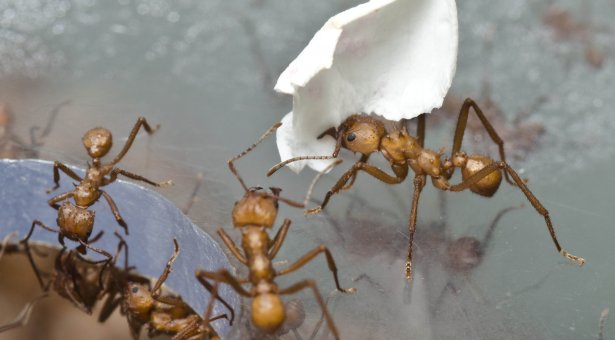Ants and antibiotics

Norwich scientists are investigating sources of antibiotics which may sound surprising – including ants, stick insects, soil and potatoes.
Many new antibiotics will be discovered from soil bacteria Actinomycetes, from which half of all antibiotics already in circulation also originate.
John Innes Centre scientist Professor Mervyn Bibb and his colleagues now understand how these bacteria make many of them, and they can now manipulate those bacteria to make new antibiotics.
Other scientists at the John Innes Centre and the UEA are investigating more unusual sources such as the surface of leafcutter ant bodies, eucalyptus leaves and even potatoes.
South American leafcutter ants are living under the spotlight within the insectary at the centre’s entomology facility. This species is better known for marching through rainforest in single file carrying leaf sections twice their size. Now they can be viewed on an “ant cam” farming the fungus on which they feed.
Leafcutter ants do not eat the leaf sections they carve from plants, but transport the material underground where it decays and forms a garden of fungus. To protect this food source from unwanted microbes and parasites and to regulate the growth of the fungus, the ants also cultivate antibiotic-producing bacteria on their own bodies.
One antibiotic already discovered on leafcutter ants is related to an antifungal used in modern medicine. It is also 300 times more soluble in water making it potentially more useful. Dr Matt Hutchings from UEA hopes that studying the ants will uncover completely new antibiotics too.
The insectary is also hosting the Giant Lime Green stick insect and the Death’s Head Hawkmoth. In the wild, the stick insect feeds primarily on eucalyptus, and the hawkmoth primarily on potato. These plant foods both contain toxins that may have antibacterial properties. The guts of these insects have been found to contain antibiotic-resistant bacteria, so the scientists know they have been exposed to antibiotics through their food.
“This research is at the very early stage but it is exciting to investigate new solutions to the increasing problem of antibiotic resistance,” said Katarzyna Ignasiak who is carrying out the work with insects at the John Innes Centre.
The work with soil bacteria is at a more advanced stage and research carried out in Professor Bibb’s laboratory has contributed to the progression of an antibiotic towards Phase II clinical trials by the John Innes Centre spin-out company Novacta Biosystems.
